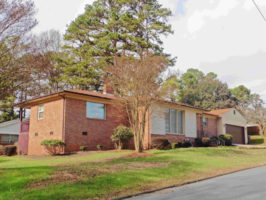1635 Van Buren Avenue
Construction of the Brookshire Freeway displaced all houses on the odd-numbered side of Van Buren Avenue about 1968.
Construction of the Brookshire Freeway displaced all houses on the odd-numbered side of Van Buren Avenue about 1968.

This house, one of the larger in McCrorey Heights, was constructed about 1957 and occupied for decades by Raymond P. Rorie, Jr., and his wife Bernice G. Rorie. Both were professionals active in education and public health. Mrs. Rorie was a case worker with the county’s Department of Public Welfare. Mr. Rorie was a teacher who also served as a guidance counselor and eventually rose to lead Westerly Hills Elementary as its principal. In 1968 Mr. Rorie became the first African American appointed to the Mecklenburg County Board of Health.

According to city directories, this house was a very late addition to McCrorey Heights. It first appeared in the directories in 1998, long after most of the neighborhood’s houses which date from the 1950s – 1960s. It was evidently a rental dwelling, with a different occupant listed each year.

Built about 1960 and first occupied by Rose M. Jones, the widow of Barnabas Jones. Mrs. Jones worked during the 1950s – 1980s as one of the public health nurses with the Charlotte Health Department.

Built about 1959 and occupied by Herman L. Counts, Jr., and wife Doris H. Counts, members of a history-making family in Charlotte’s Civil Rights era. Herman’s sister Dorothy Counts attracted international headlines when she integrated Harding High School. Both Herman and his father worked at JCSU: the father as Professor of Theology; young Herman as an administrator. Herman’s wife Doris taught at Lincoln Heights and Druid Hills elementary schools.

Built in 1955-56 for Julia McClellan and her husband James D. McClellan. When the city directory first included the house in 1957, it gave no occupation for Mr. McClellan and showed Mrs. McClellan working as a teacher Northwest Junior High School located on Beatties Ford Road. By 1961 Mrs. McClellan was listed as “widow.”

Built in 1957 for Joe Bogle, one of several brickmasons who constructed homes for their own families in McCrorey Heights, and his wife Emma Bogle, a teacher at West Charlotte High School. Subsequent longtime owners were Baxter Smoot and his wife Mary Smoot, both educators in the public schools.

Built about 1958 for Ray Booton, Jr., a member of Charlotte’s distinguished Tate family, who repeatedly made headlines as a Civil Rights pioneer. In 1946 Booton became one of Charlotte first eight black full-time policemen. Five years later he helped launch the lawsuit that desegregated Charlotte’s Bonnie Brae Golf Course (now the Dr. Charles L. Sifford Golf Course at Revolution Park). In 1999 he was inducted into the National Black Golf Hall of Fame and since 1992 a “Ray A. Booton Golf Classic” has been played in Charlotte to benefit his fraternity, Kappa Alpha Psi.

This is one of a row of four houses “spec built” by local contractor Wheatley & Co. The firm took out all four permits on the same day, April 22, 1955, to construct 1800, 1804, 1808, and 1812 Van Buren Avenue.
Chester Donald, a teacher at Northwest Junior High on Beatties Ford Road, became the first resident here at 1800 Van Buren along with wife Jessie N. Donald.

This is one of a row of four houses “spec built” by local contractor Wheatley & Co. The firm took out all four permits on the same day, April 22, 1955, to construct 1800, 1804, 1808, and 1812 Van Buren Avenue.
Rev. P.L. Ross, a Presbyterian minster who served small-town churches outside Charlotte, moved here with his family as soon as construction was complete. The Ross family occupied the dwelling continuously for more than six decades.